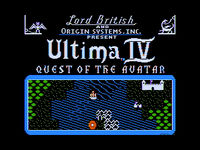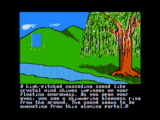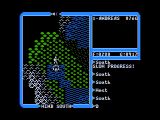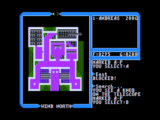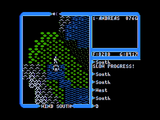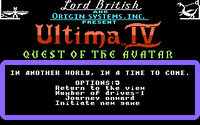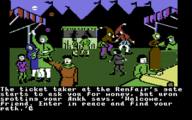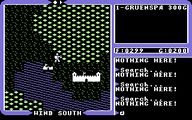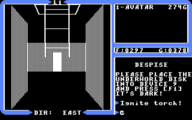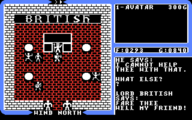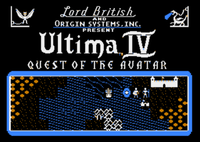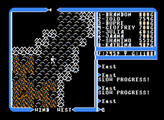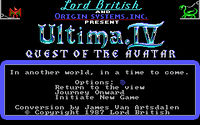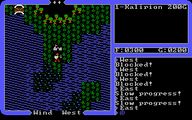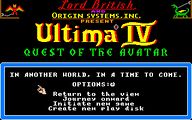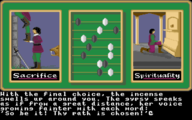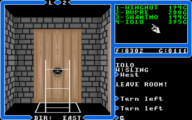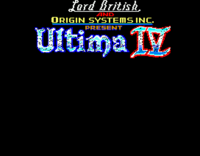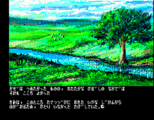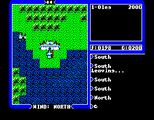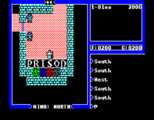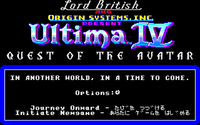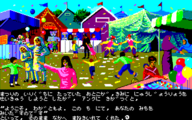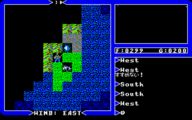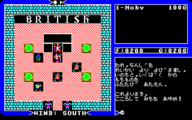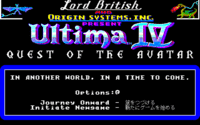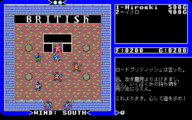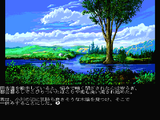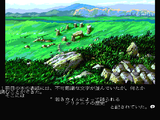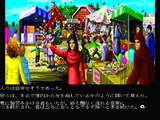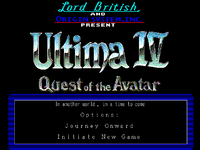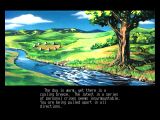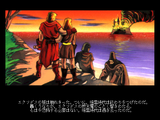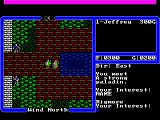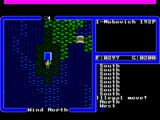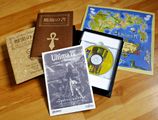Computer ports of Ultima IV
This article is about desktop computer ports of Ultima IV. For console ports, see Console ports of Ultima IV.
Ultima IV was developed for the Apple II and therefore, all ports are based on that version. These ports include the IBM PC, various Commodore, Atari and Japanese computers.
The 8-Bit-Ports[edit]
The Apple II Original[edit]
The Apple II version has the full musical score, but needs a Mockingboard to benefit from it. For 1985, the graphics are good quality, although there are still color problems (like purple colored brick floor). This version also has several glitches caused by the fact that it is the original, for example there are quite a few spelling errors in the NPC conversations, and the game cannot agree on whether a certain dungeon is called "Destard" or "Dasterd". Other bugs concern the balloon, Shamino in Skara Brae and shrine messages that were not displayed.
The game came on two double-sided 5.25" floppy disks, making disk-swapping tolerable as they are divided into logical chunks (towns, dungeons...).
Another notable requirement is 64kb of RAM (listed as a sticker on the box), as the older Apple II and Apple II+ models (before the Apple IIe) never shipped with more than 48kb factory-installed memory, which was also the limit of how much RAM could be installed on the mainboard of those systems. They needed an expansion card (a so-called “language card”) to get to 64kb.
There are differences in gameplay as well. If a single party member flees from combat prematurely, Valor and Sacrifice are lost whereas in the PC version the entire party must flee.
The C64-Port[edit]
The port for the C64 – made by Chuckles – looks graphically a lot like the original on the Apple II, although it does fix the color problems of the original (the brick floors are now red) and also has some graphical improvements. As with the C64-port of Ultima III, however, the dungeons are rendered in monochrome and not in color. The C64 port also has the full musical score with no additional sound hardware required (though reduced to three voices; the Apple version supports up to six).
It was sold on two double-side 5.25" floppies. Fortunately, the division was logical and prevented excessive disk-swapping.
- Game (boot, character data, introduction, finale)
- Towne (as name says, also castles and villages and all character conversations except for Lord British)
- Britannia (the overworld, plus conversation with Lord British)
- Dungeon
A drawback of this version is that the game did not include a software fastloader to enhance the notoriously slow speed of the Commodore 1541 disk drive, resulting in very long waits when the game has to load (even if it is only a conversation). Additionally, the C64-port generally runs a bit slow.
In 2006, a crack of the port known as Ultima IV Gold was released by MagerValp. This crack included numerous bug fixes and improvements, including built-in data compression and support for the Commodore 1571 and the Commodore 1581, allowing the entire game to fit on a single double-sided 5.25" or 3.5" floppy, and thus eliminating disk-swapping for owners of one of these drives. For Commodore 1541 owners, disk-swapping is all but eliminated, as this crack can fit on two disk sides for this drive.
In 2015, an updated port was released, called Ultima IV Remastered. It builds upon Ultima IV Gold but adds updated graphics, mixed case text, dozens of game bugfixes, and a cartridge version.
The Atari 8-bit-Port[edit]
The port for the Atari 8-bit is essentially the same as the Apple II original. Origin utilized Atari's high resolution 320x192 graphics mode with artifacting to provide color. Ultima IV is able to detect the Atari system on which it is running and adjust the colors. They closely resemble the colors used on the Apple II version. However, as for most Ultimas it will still be in black and white on European (PAL) Ataris, which do not offer artifacting at all.
In order to provide support to the majority of Atari users Origin only utilized 48k of ram which prevented adding the complete musical score. Basic sounds from the Apple were again ported.
This would be the last Ultima game to be released for the Atari 8-bit family, although work was begun on a port of Ultima V and some of that work survives.
The 16-Bit-Ports[edit]
The IBM PC, Amiga and Atari ST-Ports[edit]
The 16-bit ports of Ultima IV have some novel qualities. Unlike the previous two parts, Ultima IV was the one where the graphics for the Amiga, Atari ST and IBM PC were similar. Nonetheless, there are obvious differences between these three ports.
The PC-port was released in the same year as the original, made by James Van Artsdalen. It sports much improved graphics in EGA-graphics mode (a CGA mode for composite monitors was also available) over the 8-bit computer ports. However, it comes at the price of the music missing from this port. At the time, there were no music cards available for PCs until AdLib entered the market in early 1988. Only some sound effects from the PC-speaker are available. Fortunately, the Ultima IV Upgrade Patch re-inserts the music, beside a graphical update.
The IBM PC-port was sold on two 5.25" disks.
The ports for the Amiga and Atari ST were released three years after the original, which of course meant that there would be improvements over the PC-port. While both ports use the same graphics for the overworld, the dungeons look much nicer and realistic. Also, both ports have a mouse-driven interface and the full musical score. Strangely, the title screen also looks different. The graphics for the introduction were polished as well, since the PC-port has rather strange colors (yellow for skin for example).
Both ports are like identical twins, obviously because they were both made by "Banjo" Bob Hardy. Also, both were sold on a single 3.5" floppy disk, eliminating disk-swapping.
There is just one small difference between the two: in fact, only the Atari ST allows to transfer the character to Ultima V.
The Japanese-Ports[edit]
The MSX-Port[edit]
Pony Canyon released a port from the MSX. However, it was only released in Japan in 1987 and only exists in Japanese.
The game use a tileset that appears very similar to its Ultima I-port. However, much like that one it suffers from the same pixelisation issues due to the low resolution of the system, although not quite as much. It was released on two 3.5" disks. Other than that, it is a prefect copy of the original version, even using the same music.
The MSX-port of Ultima IV is has similar graphics and gameplay to the PC-8801-port included with the Japanese Ultima collection, also developed by Pony Canyon which come from the PC-98-port.
The PC-8801-Port[edit]
The PC-8801-port of Ultima IV was originally translated by Fortune in 1987, produced by Newtopia Planning, and distributed by Pony Canyon. This version featured graphics and sound support nearly identical to the MSX-port of Ultima IV featured above, and has the same soundtrack as the original Apple II version. The icons in this version have no background transparency, thus they always have a black box around them, which is noticeable due to the bright backgrounds.
This version was re-released in 1998 as a part of the Japanese version of the Ultima Collection.
PC8801 – Lord British
The PC-9801 and Sharp X68000-Ports[edit]
The PC-9801-port of Ultima IV was released at the same time as the previously described PC-8801-port, and was also originally translated by Fortune in 1987, produced by Newtopia Planning, and distributed by Pony Canyon, which also distributed MSX and PC-88-ports. This version featured superior graphics to the PC-8801 port due to a better system hardware, and has the same soundtrack as the original Apple II version.
The port of the Sharp X68000 is identical to this one, but has a redrawn introduction.
The FM Towns-Port[edit]
The FM Towns-port of Ultima IV was released in Japan in 1992. While the FM Towns was capable of handling high color 640x480 graphics, the designers chose to update the introduction and endgame graphics only – and even these are only in upscaled 320x240, apart from the text. In-game graphics are low-quality copies of the 16-bit graphics released with Ultima V for the PC, with a strange color palette. In the dungeons, all the walls and ladders are shown in unasthetic variations of green or gray. There also is always a pink bar at the top where messages related to data reading and writing are displayed.
The title screen uses a high quality CD-format of the town theme. Other differences from the PC version consisted of an introduction screen allowing the player to choose to play in either English or Japanese. The title screen also allowed the player to review the story from Ultima III in Japanese. The review contains high quality graphics not previously seen in an Ultima game and plays a CD-quality rendition of Stones.
FM Towns – wilderness near a moongate
See Also[edit]
External Links[edit]
- YouTube – Ultima IV (Apple) Gameplay Video
- YouTube – Ultima IV (Commodore 64) Gameplay Video
- YouTube – Ultima IV FM Towns Story
- Screenshots of the ports at MobyGames
| Computer Ports | |
|---|---|
| Games | Ultima I ☥ Ultima II ☥ Ultima III ☥ Ultima IV ☥ Ultima V ☥ Ultima VI ☥ Savage Empire |
